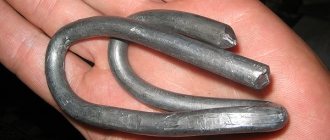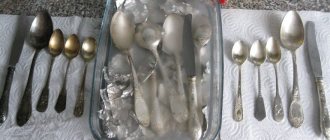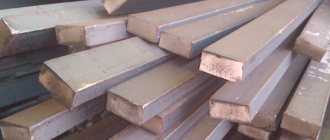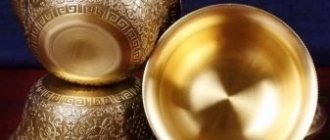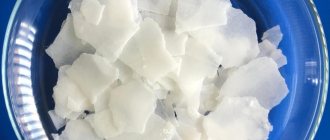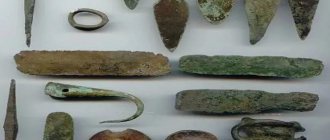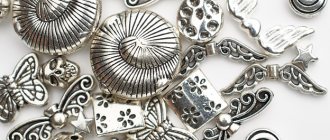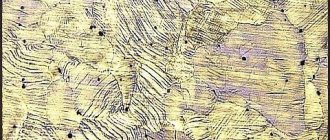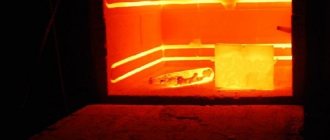What is nickel silver? Judging by its composition and properties, we can say that it is an improved version of an older alloy - cupronickel, invented back in 1819. Unlike cupronickel, which consists only of copper and nickel, nickel silver also necessarily contains zinc, and in addition to it, iron and some other alloying elements.
History of origin
As usually happens in life, the reason for the birth of a new alloy was an acute shortage of more valuable and expensive metal. This was the case with the ancestor of nickel silver - cupronickel. The lack of silver for minting the most popular coins forced the rulers of China to order several government agencies to find a cheap replacement. History says that in the 8th century. BC e. the solution was found in a very original way - alchemists and counterfeiters proposed a recipe for a new alloy, which did not contain a single gram of silver, but the coins were of such high quality that even the craftsmen could not distinguish cupronickel coinage from real silver ones. As a result, the former received a huge reward in the form of saved silver, the latter received life, which is also important, but humanity gained a new alloy of copper, nickel and zinc with excellent chemical and physical properties.
But, as befits a secret, the secret of cupronickel’s components was carefully protected by the state, so alchemists in many countries continued to work on finding a recipe for “new silver.”
History, with a slight amendment, repeated itself in the 19th century in Germany. Germany, famous for its metallurgists and chemists, experienced an acute shortage of silver. It got to the point that silver coins began to be valued several times higher than their face value. And only the emergence of a new alloy - nickel silver - made it possible to solve this problem.
Nickel silver wire
The resulting alloy was not only cheaper than cupronickel, but also had higher chemical qualities - it did not corrode, was mechanically strong, malleable, and most importantly, it was susceptible to destruction in a boiling solution of sulfuric and hydrochloric acids.
The industrial production of nickel silver occurred at the beginning of the 19th century, then during the time of Napoleon, a similar composition was obtained by French chemists. And as often happens in history, each of the inventors gave his brainchild his own name. The French - Myshore, the Germans - German silver. But fate turned out to be favorable to the Germans; they did not limit the use of metal only to the issue of coins - they went further, cutlery, gift plates and glasses, inexpensive jewelry and watches appeared from it, as from cupronickel. So it was the name nickel silver that finally stuck, displacing its French counterpart.
Since 1825, the name was finally assigned to the alloy for cutlery and jewelry.
But in Russia it did not take root. The name cupronickel was actively used here. At the same time, the metal was mainly used by wide sections of the population; the intelligentsia, townspeople and wealthy peasantry could afford dishes and jewelry made from “Polish silver” and “German alloy”. Namely, the term “nickel silver” is firmly entrenched in the vocabulary of professionals - metallurgists, chemists, jewelers and merchants.
Cupronickel silver cutlery: alloy composition
An alloy of light-colored metals, which is now universally known under the name cupronickel, appeared in ancient times. In Mesopotamia, around the third century BC, it was called white copper and was widely used in the production of utensils, various vessels and household items. Then, in numerous wars and under the influence of time, the secret of alloy technology was lost for several thousand years.
It is believed that cupronickel was invented, or rather recreated, by the French inventors Maillot and Chaurier in the nineteenth century. Despite the fact that the invention was made by the French, cupronickel silver was called “German silver” for a long time. Kitchen utensils, dishes, church vessels, and decorations were made from it.
Alloy properties
The alloy formulation includes zinc, copper and nickel. These components provide high levels of corrosion resistance. But for better mechanical processing, lead is added to the composition. This metal makes the alloy softer, more malleable, and reduces brittleness at low temperatures.
In the steel and alloys brand, nickel silver is marked MNTs and MNTsS, respectively copper-nickel-zinc and copper-nickel-zinc-lead. In the decoding of the compositions, after the abbreviation there is a digital code - MNC 15-20. The numbers show the percentage of nickel and zinc in the material. The industry today produces about 50 grades of copper-nickel alloy, of which MNTs 15-20 and MNTs 16-29-1.8 are most often used in the jewelry and food industries.
The constituents of an alloy are important to the physical and chemical properties of the metal. Nickel in the formulation provides mechanical strength and corrosion protection. The copper-nickel alloy has high mechanical strength and oxidation resistance. At the same time, the strength increases by 10-12 times compared to pure copper. At the same time, it is the nickel content in the composition that makes the alloy very expensive.
The introduction of zinc into the composition reduced the cost of the product. In addition, zinc imparts even greater strength; tests show that strength can reach 30 HRC. True, in this case it is necessary to use annealing. Zinc also affects the electrical conductivity of the metal; it significantly increases the resistance. But as for processing, it becomes possible to subject the metal to forging, which is used in coinage. True, there is a minus - zinc reduces the melting point.
Lead in all alloys imparts ductility, thanks to which the metal can be drawn, bent, twisted and processed with a press. Alas, lead does not contribute to the formation of strength, especially when heated - the alloy is susceptible to brittleness when heated.
What is the difference between cupronickel and nickel silver?
The main difference between cupronickel and nickel silver is the presence of zinc in the composition of the latter. Cupronickel is an alloy of copper (80%) and nickel (18%) with a silvery color. Nickel silver is an alloy of zinc, copper and nickel.
The most significant property of cupronickel is its increased resistance to corrosion. It is highly durable and looks similar to silver. Due to these qualities, it is often used in the production of tableware.
Externally, cupronickel and nickel silver are very similar. Therefore, the question arises of how to distinguish nickel silver from cupronickel. At first glance, it is almost impossible to distinguish them. The distinction can only be made by knowing the composition of the alloys.
Chemical
Nickel silver has high corrosion resistance for both acidic and alkaline environments; resistance to organic acids is especially high. Resistance to environmental factors is high - it does not react with air even when heated to a temperature of +250 degrees. In relation to salts under normal conditions it exhibits an inert reaction.
Nickel silver has high corrosion resistance
Physical properties
The alloy has a silver-whitish color. Due to the nickel content, copper “bleaches” occurs.
- The standard density for MNTs 15-20 alloy is 8700 kg\cub.m.;
- The alloy has high electrical resistance - 0.26 Ohmxmm2\m;
- Thermal conductivity is low 0.06-0.085 cal/cm;
- When heated, it retains its shape, has an insignificant coefficient of linear expansion, and when heated to 100 degrees, the expansion is 16.6 microns.
- Melting point – 1452 degrees;
Technological characteristics
During the melting process, the red tint of the copper is absorbed by the nickel. The result is an alloy of white, white with a blue or greenish tint with a deep glossy texture.
When lead is added to the alloy, the glossy shine fades and a gray tone clearly appears. The specific gravity of the copper-nickel alloy is 7.5 grams per cubic meter. cm.
For further processing, ingots, rods, strips, pipes and wires are produced. The main processing method is cutting and pressure forming. Nickel silver can be heated and cooled, forged, and minted.
When using nickel silver as tableware, the metal is plated with silver or gold. For instruments and electrical products, the metal is polished to a mirror finish.
When covering cutlery, the layer of silver or gold plating is regulated by state standards - for forks and spoons it must be at least 24.00 microns, for knife handles 18.0 microns.
Is cupronickel harmful to health?
Alloys are not only not harmful, but even beneficial to health. After all, cupronickel contains:
- Nickel – as it accumulates in the body, contributes to the long-term maintenance of low blood glucose levels and enhances the beneficial effect of the hormone insulin. Nickel ions promote better absorption of vitamin C and stabilize blood pressure.
- Copper is one of the components of human blood; it is part of enzymes and destroys pathogenic bacteria.
- Cupronickel alloy has a beneficial effect on the skin. Increases elasticity and maintains youth. With constant use of water saturated with cupronickel ions, it reduces the number of wrinkles.
Applications of nickel silver
Nickel silver has found its main use not in jewelry, but in components for the radio engineering industry. The alloy composition of nickel silver, purified from impurities, contains no more than 0.1% of impurities of other metals, is used as relay elements, springs and housing plates. The absence of corrosion on the surface and the ability to achieve high polishing purity have made the alloy one of the main metals for instrument dials. Nickel silver wire is used as scale divisions on high-precision mechanical instruments.
Nickel silver is used in the radio engineering industry
The second most important place where nickel silver is in demand is the production of memorial signs, insignia, award products and coinage. For some mints, nickel silver alloy has become a strategic raw material; most coins for everyday circulation are minted from it. Metal resembling silver is also excellent for applying gilding; a number of state and public awards have this appearance.
For the jewelry industry, in addition to ingots, rolled sheets and strips, nickel silver wire is of great importance - it is the main product for the manufacture of costume jewelry and the basis for jewelry. For this purpose, the nickel silver alloy composition MNTs 15 is most often used. Due to its qualities, this particular brand is popular for men's products - corporate signs, hairpins, cufflinks. Metal is also highly valued in such piece goods as fountain pens. In Asian countries, nickel silver, like cupronickel, is actively used for the manufacture of watch cases and bracelets.
The use of the alloy for medical purposes is limited due to nickel, an active allergen, which is why it was abandoned as a basis for metal prostheses and instruments. But, since it is perfectly disinfected and does not come into contact with acids and alkalis, individual elements of medical equipment are made from nickel silver.
Food grades of nickel silver are used to produce cutlery and tableware. True, the metal itself should not come into contact with food, otherwise the food will have a peculiar metallic taste. To do this, gold or silver plating is done on the surface of the dishes.
The discovery of the alloy to the general public allowed it to be used in architecture - nickel-silver wire is used to decorate interiors, ribbon has become one of the attributes of decorating cast iron, and foil is used by restorers and artists.
In Moscow, many buildings from the first half - mid-20th century have elements of this alloy in their decoration. Many watchmakers, along with bronze, use metal as casting for mantel clock cases. Many genre subjects made of nickel silver look much more impressive than those made of bronze. That is why in Europe metal is often used to restore city clocks on town halls.
How to make cupronickel dark?
Darkening nickel silver, nickel silver, brass, and other alloys containing copper makes objects more attractive. Under normal conditions, the process can last for years, but with the help of chemical solutions, artificial aging can be achieved instantly.
Before patination, you need to check safety precautions, since some chemical solutions are extremely toxic and emit fumes that are harmful to health. It is necessary to provide exhaust and fresh air supply.
The products must first be cleaned, degreased and washed with warm water, and dried thoroughly.
There are several ways to darken alloys:
- Using “sulfur liver” - mix powdered sulfur with potash 1:2, then put the composition in an unnecessary tin on the stove and after melting begins, heat for another 15 minutes. Cool, grind into powder, store in a sealed container. To darken the object, immerse it in a solution of 1 liter of water and a mixture - from 1 to 20 g. The more powder, the darker the product will become.
- Nickel silver alloys can be darkened with copper sulfate dissolved in water, into which ammonia is poured until a rich blue color is obtained. The object is immersed for some time in the resulting liquid and then slightly heated.
- You can treat the item with a solution of platinum chloride or immerse the item in it. If the darkening is insignificant, then pour a little hydrochloric acid into the solution.
Nickel silver products and features of their care
Initially, the alloy, due to its characteristics, does not require special care or special storage conditions. But, like jewelry and silverware, you need to pay attention to this metal from time to time.
In order to preserve nickel silver products longer, it is recommended:
- Use a separate box or place for storage, protected from direct sunlight and dust;
- There is no need to bend, break, test for strength, everything can be broken if desired;
- For products made from non-silver wire, it is recommended to clean them with a natural bristle brush and undergo special cleaning in a jewelry workshop;
- It is recommended to cover awards, orders, commemorative medals and badges with a special colorless varnish to protect them from scratches;
- If darkening of the metal is detected, it is recommended to wipe it with a special napkin for caring for jewelry;
- Items that have a high degree of polish are recommended to be wiped with felt at least once a month;
- You should not constantly wear alloy jewelry, especially if it concerns water procedures, visiting a sauna, or spa salons;
- You need to treat jewelry and cutlery especially carefully and with care. They are usually cleaned 1-2 times a month.
If a product breaks, it is recommended to take it to a jewelry workshop for repair, rather than try to solder or glue the torn element yourself.
Taking these simple recommendations into account, you can be sure that jewelry, costume jewelry and tableware will delight you with their appearance for a long time.
Nickel silver as a coin metal
Although nickel silver has never been a popular alloy for coinage, it has sometimes been used for commemorative, limited or collector's editions, as well as specific single editions.
An example is the 20 kopeck coins minted in 1961. The design of the coin was not complex - it was an ordinary batch. And now among numismatists, samples of twenty-kopeck coins from 1961 are not valued very highly, despite the uncharacteristic metal.
In recent years, commemorative coins made of nickel silver have been minted in Ukraine and Kazakhstan. In Kazakhstan, these are a series of coins with a face value of 50 tenge, dedicated to one of the themes: “Fairy Tales”, “Space”, “Cities”, “Red Book”. In Ukraine, coins of different circulations and denominations were minted: in honor of famous people, memorable dates (many relate to the Great Patriotic War), cities.
